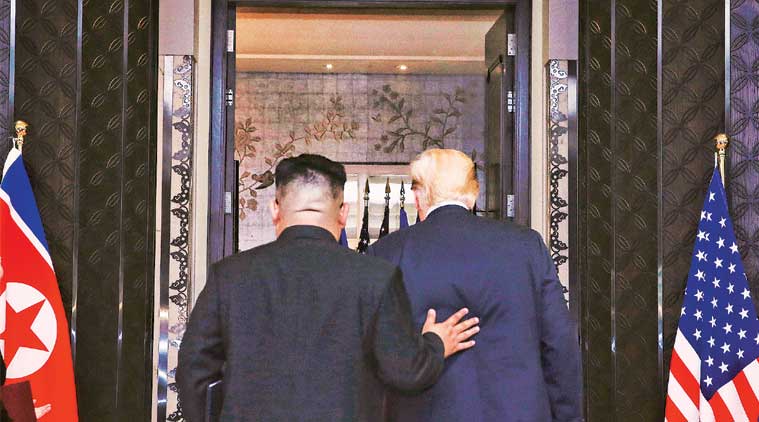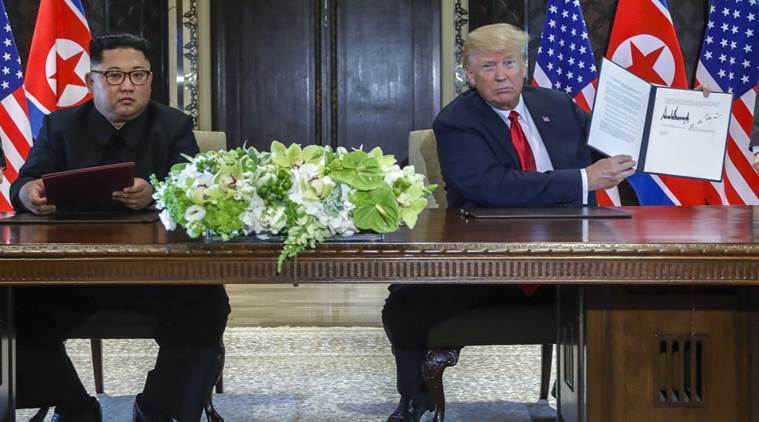 US President Donald Trump, North Korean leader Kim Jong-un leave after a signing ceremony Tuesday at the Capella resort on Sentosa island in Singapore. (AP/PTI)
US President Donald Trump, North Korean leader Kim Jong-un leave after a signing ceremony Tuesday at the Capella resort on Sentosa island in Singapore. (AP/PTI)
Many leaders promise fundamental changes in the existing order, but only a few get to have a shot at it. US President Donald Trump and North Korean leader Kim Jong-un might be among those few. At their much anticipated summit meeting here Tuesday, Trump and Kim Jong-un have begun an unprecedented effort to dismantle a seven-decade-old conflict in the Korean Peninsula. Working together with South Korean President Moon Jae-in, Trump and Kim are getting ready to turn Asian geopolitics inside out.
The story of the summit between Trump and Kim began as a narrow narrative on de-nuking North Korea. It has now turned into an extraordinary tale of turning sworn enemies — Washington and Pyongyang — into friends, healing the tragic partition of the Korean Peninsula, and reducing American forward military presence in East Asia.
In publicly discussing the prospect of withdrawing American troops from South Korea at some future date when peace prevails in the Peninsula, Trump has set a cat among the Asian pigeons. In hinting at potential American military retrenchment, Trump might compel the region to seek a new balance of power.
 Singapore: US President Donald Trump holds up the document that he and North Korea leader Kim Jong Un signed at the Capella resort on Sentosa Island Tuesday. (AP/PTI)
Singapore: US President Donald Trump holds up the document that he and North Korea leader Kim Jong Un signed at the Capella resort on Sentosa Island Tuesday. (AP/PTI)
But first to the three principles outlined in the deceptively bald statement issued after the meeting between Trump and Kim. For the nuclear nerds and the media focused on ‘complete, verifiable, irreversible disarmament’ — CVID for short — it is a rude shock to find it missing in the joint statement.
To be sure, there is a reference to ‘complete denuclearisation’ in the third principle and Kim’s ‘firm and unwavering commitment’ to it. But it is embedded in a larger political construct about changing the nature of the political relationship between America and North Korea. If American conventional strategic wisdom put the technical above the political, Trump has reversed the equation.
The first principle in the joint statement talks about commitment of Trump and Kim to establish a new relationship between the two nations. The second principle connects nuclear disarmament to the de-escalation of the larger security dynamic in the Peninsula. It calls for a joint effort to build a ‘lasting and stable peace regime’.
This is probably the most weighty element of the framework unveiled by Trump and Kim. This is where the question of American security guarantees to North Korea come. Trump’s comments at the lengthy press conference after the talks go a long way in assuring Kim that Washington is not contemplating regime change in North Korea.
 US President Donald Trump and North Korea’s leader Kim Jong Un walk during their summit at the Capella Hotel on Sentosa island in Singapore June 12, 2018. (Anthony Wallace/Pool via Reuters)
US President Donald Trump and North Korea’s leader Kim Jong Un walk during their summit at the Capella Hotel on Sentosa island in Singapore June 12, 2018. (Anthony Wallace/Pool via Reuters)
Trump refused to rise to the bait when the Western journalists repeatedly pushed him on the question of human rights in North Korea. He showered praise on Kim as a ‘talented leader’. He did not flinch from his emphasis on building friendship with Kim. He went lyrical on the shared destiny of North and South Korea and the benefits of national reconciliation in the Peninsula.
Even more important, Trump announced that he is suspending the routine US military exercises in South Korea that the North has always seen as provocative. The peace regime could also involve many measures to de-escalate the military tensions between North and South Korea.
Trump’s musings on bringing home the 32,000 US troops in South Korea at some point in future has sent shock waves through the American establishment. While the President insisted that the withdrawal is not on the cards for now, he has revealed an important element of his world view.
 US President Donald Trump and North Korea’s leader Kim Jong Un shake hands during the signing of a document after their summit at the Capella Hotel on Sentosa island in Singapore June 12, 2018. (Susan Walsh/Pool via Reuters)
US President Donald Trump and North Korea’s leader Kim Jong Un shake hands during the signing of a document after their summit at the Capella Hotel on Sentosa island in Singapore June 12, 2018. (Susan Walsh/Pool via Reuters)
During his campaign for Presidency in 2016 — before that as well as since — Trump has consistently raised questions about the costs and benefits of US military presence in Asia. He has insisted that America’s allies must do more. In suggesting that the region must fend for itself, Trump has opened up space for rearranging the international relations of East Asia.
Trump is not the only revisionist in Asia. Kim’s emphasis on economic modernisation has turned the nuclear arsenal into a negotiating instrument rather than an end in itself. Moon, without whom Trump and Kim could not have got to Singapore, has defied the conventional wisdom in betting that reconciliation with the North is possible.
As the trio disrupts the regional order, two nations will put on their thinking hat. Both Tokyo and Beijing are deeply wary of Korean nationalism and the potential unity between North and South. Japan’s premier Shinzo Abe will have no choice but to evaluate Japan’s national security options if he sees that Trump is bent on scaling down American commitment to Asian alliances.
China, which should have been happy at American retrenchment, has reasons of its own to worry. For the strategic vacuum resulting from such retrenchment will create many new instabilities, encourage its Asian neighbours to strengthen their national military postures, including the consideration of nuclear weapons.
But nowhere is the shock more apparent than in Washington where Trump’s Korean framework is generating a political backlash. His ability to mollify the domestic reaction would depend on how quickly he can move, along with Kim and Moon, in translating the Singapore framework into concrete outcomes. If the three disrupters stumble, the old order will strike back with great force.